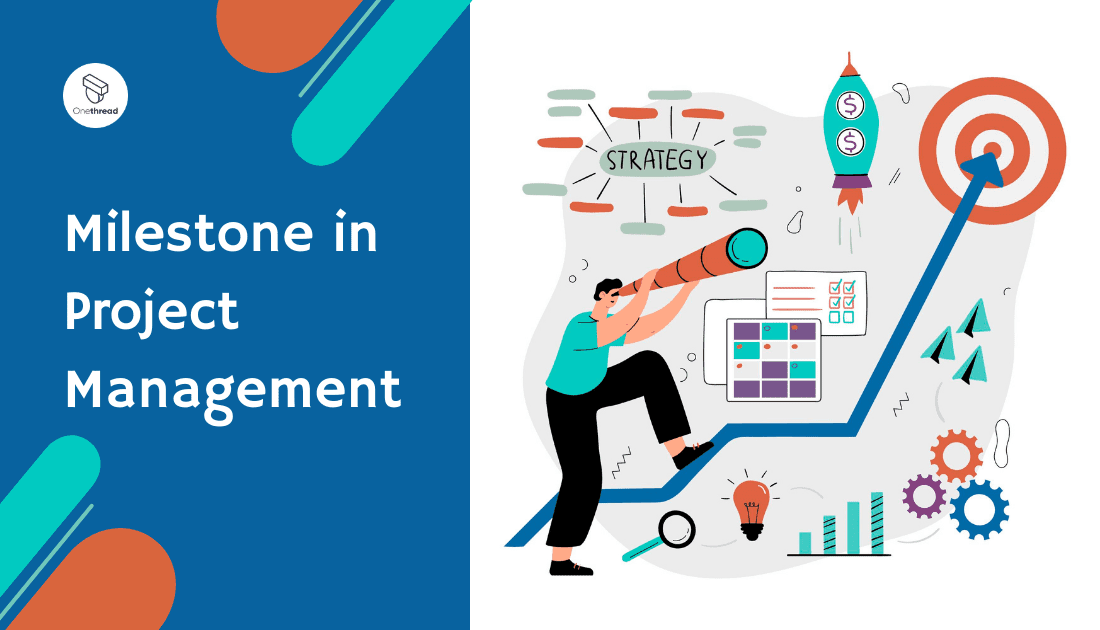Have you ever wondered what exactly a milestone is in the world of project management? Whether you’re a seasoned project manager or just starting out, understanding milestones is crucial for successfully navigating your projects.
So, what is a milestone in project management, you ask? Think of it as a significant marker or checkpoint that helps us track and evaluate progress along the way. It’s like those little flags we plant on a map to mark the key stops on our journey. These milestones serve as important signposts, indicating that we’ve reached a specific point in our project and achieved a particular outcome.
In this article, we’ll dive deeper into the world of milestones, exploring their purpose, characteristics, and how to effectively incorporate them into your project management toolkit. So, let’s get ready to hit those milestones together!
What Is a Milestone in Project Management? – The Definition
In simple terms, a milestone is like a big, shiny signpost that marks a significant achievement or event in your project. It’s like reaching the top of a mountain and taking a moment to appreciate the view before continuing your journey. These milestones help us track progress, stay organized, and celebrate our accomplishments along the way.
Picture it like this: You have a project with multiple tasks and activities, right? Well, milestones act as key checkpoints that let us know we’ve reached a major stage or completed a critical deliverable. They’re like little victories, guiding us forward and keeping us motivated.
Milestones are powerful tools for communication too. They allow us to share progress updates with our team and stakeholders, showcasing our hard work and the significant milestones we’ve hit. Plus, they help us identify any potential roadblocks or delays early on, so we can course-correct and keep things on track.
Why You Must Set Milestones in Project Management?
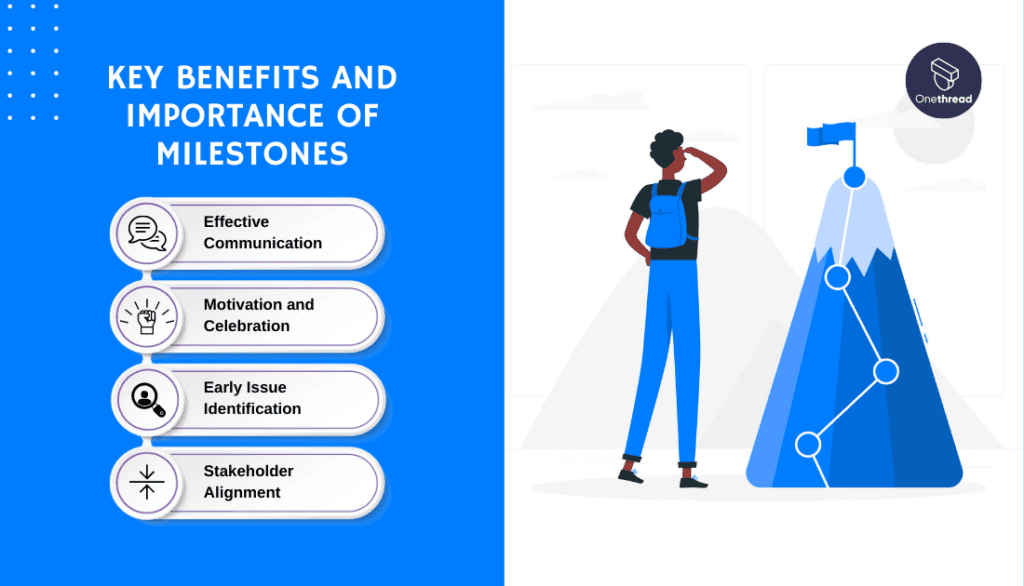
Setting milestones in project management is absolutely essential for a successful project journey. Let me break it down for you and highlight the key benefits and importance of incorporating milestones into your project management approach.
Effective Communication
Effective communication is vital in project management, and milestones play a crucial role in this area. They act as visual cues, making it easier for you to communicate progress to your team, stakeholders, and clients.
Milestones serve as concrete evidence of achievement, providing a shared understanding of what has been accomplished and what lies ahead.
Motivation and Celebration
When you set milestones, you create mini-goals that give you and your team a sense of achievement. As you reach each milestone, it’s important to celebrate these victories.
Acknowledging progress and celebrating milestones boosts morale, motivates your team, and reinforces a positive project culture.
Early Issue Identification
Milestones act as checkpoints where you can evaluate the health of your project. They help you identify potential issues or delays early on, enabling you to address them proactively.
By regularly assessing your progress against milestones, you can quickly detect deviations from the plan and take corrective measures, minimizing the impact on the project timeline and objectives.
Stakeholder Alignment
Projects involve multiple stakeholders, each with their own interests and expectations. Milestones provide a common framework for aligning stakeholders’ understanding and expectations.
When everyone knows what the key milestones are and when they will be achieved, it fosters transparency, collaboration, and trust among the project team and stakeholders.
6 Best Examples of Milestones in Project Management
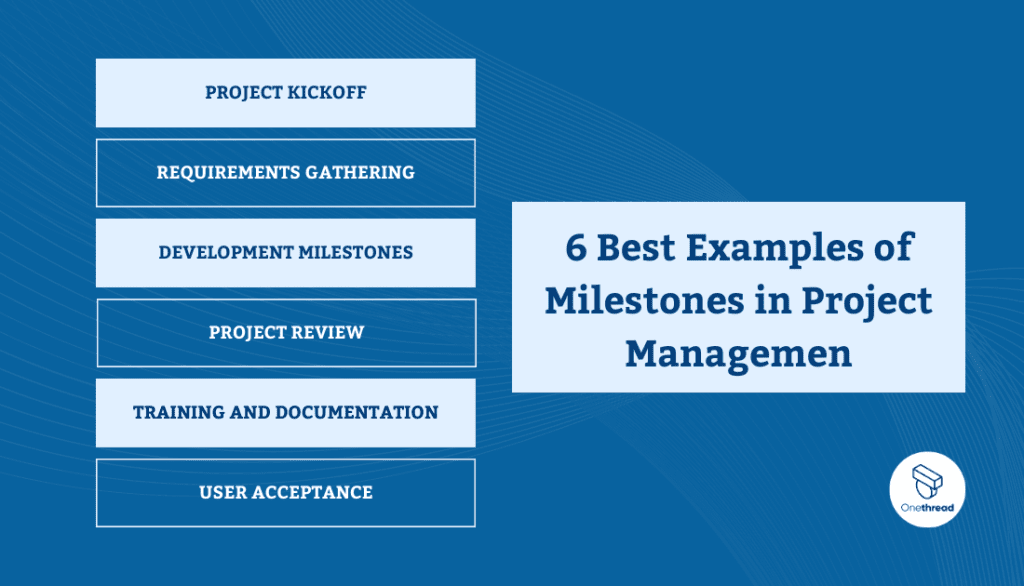
When it comes to project management, milestones serve as important markers of progress and achievement. Let’s explore the 6 best examples of milestones that are commonly used in various projects.
Project Kickoff
The project kickoff milestone marks the official start of the project. It involves gathering the project team, defining objectives, and setting expectations. Holding a kickoff meeting or completing a project initiation document are typical activities associated with this milestone.
Requirements Gathering
This milestone signifies the completion of gathering project requirements. It could include activities such as conducting interviews, surveys, or workshops to gather necessary information. Achieving this milestone ensures that you have a clear understanding of what needs to be delivered.
Development Milestones
Development milestones are crucial in software or product development projects. They mark significant stages in coding, testing, and implementation. Examples include the completion of coding, unit testing, integration testing, and user acceptance testing.
Project Review
A project review milestone involves a comprehensive evaluation of the project’s progress, performance, and adherence to quality standards. It could include activities like conducting a project audit, assessing risks, and reviewing project documentation. This milestone provides an opportunity to make adjustments and ensure the project is on track.
Training and Documentation
This milestone represents the completion of training sessions for end-users or stakeholders. It includes creating training materials, conducting workshops, and ensuring that users are equipped with the necessary knowledge to effectively use the project’s deliverables.
User Acceptance
User acceptance milestone indicates that the project deliverables have been reviewed and accepted by the end-users or client. It involves verifying that the deliverables meet the agreed-upon requirements and that they function as intended.
How Do You Decide What Is a Project Milestone and What Not?

Deciding what qualifies as a project milestone can sometimes be a bit challenging, but don’t worry, we’ve got you covered. Here are some guidelines to help you determine what should be considered a project milestone and what shouldn’t.
Significance and Impact
Ask yourself if a particular event or achievement holds significant importance in the project’s progress. Milestones should represent major accomplishments or key decision points that significantly impact the project’s trajectory. If an event or outcome has a substantial influence on the project’s success, it’s likely a milestone.
Tangible Deliverables or Outcomes
Milestones should be tangible and measurable. They often represent the completion of a deliverable or the achievement of a specific outcome. Ask yourself if the event or achievement can be clearly defined, measured, or observed. If it can be easily identified and evaluated, it’s likely a milestone.
Progress Tracking and Communication
Consider whether a particular event or achievement serves as a useful marker for tracking progress and communicating with stakeholders. Milestones should provide a sense of progress and enable effective communication about project status. If an event or outcome helps you track progress or communicate important updates, it’s likely a milestone.
Decision Points and Dependencies
Evaluate whether a specific event or achievement represents a decision point or a critical dependency for the project. Milestones often indicate when important decisions are made or when dependencies are resolved. If an event or outcome is essential for making decisions or overcoming dependencies, it’s likely a milestone.
What Is Milestone Planning?
Milestone planning is the process of identifying and setting key milestones throughout a project’s lifecycle. It involves determining specific events, deliverables, or outcomes that mark significant progress or achievement.
Milestone planning helps in organizing and structuring the project by providing clear targets and checkpoints for tracking progress. It also facilitates effective communication with stakeholders, as milestones serve as reference points for discussing project status and accomplishments.
What Are Milestone Methodologies?
Milestone methodologies refer to various approaches or frameworks used to plan, track, and manage project milestones. These methodologies provide structured guidelines and techniques for identifying, defining, and executing milestones throughout the project lifecycle.
Different project management methodologies, such as Waterfall, Agile, or Hybrid, may incorporate specific practices for milestone planning.
- For example, in the Waterfall methodology, milestones are typically defined at the beginning of the project and represent major project phases or deliverables. The emphasis is on sequential progress and meeting predefined milestones before moving forward.
- In Agile methodologies like Scrum, milestones are often referred to as “sprints” or “iterations.” These are time-boxed periods during which specific tasks or features are developed and delivered. Milestones in Agile approaches focus on incremental progress and continuous improvement.
- Hybrid methodologies combine elements from different approaches, allowing for flexibility in milestone planning. They may adapt milestone management techniques from Waterfall and Agile methodologies based on the project’s specific needs and characteristics.
What Is the Easiest Way to Create a Project Milestone?
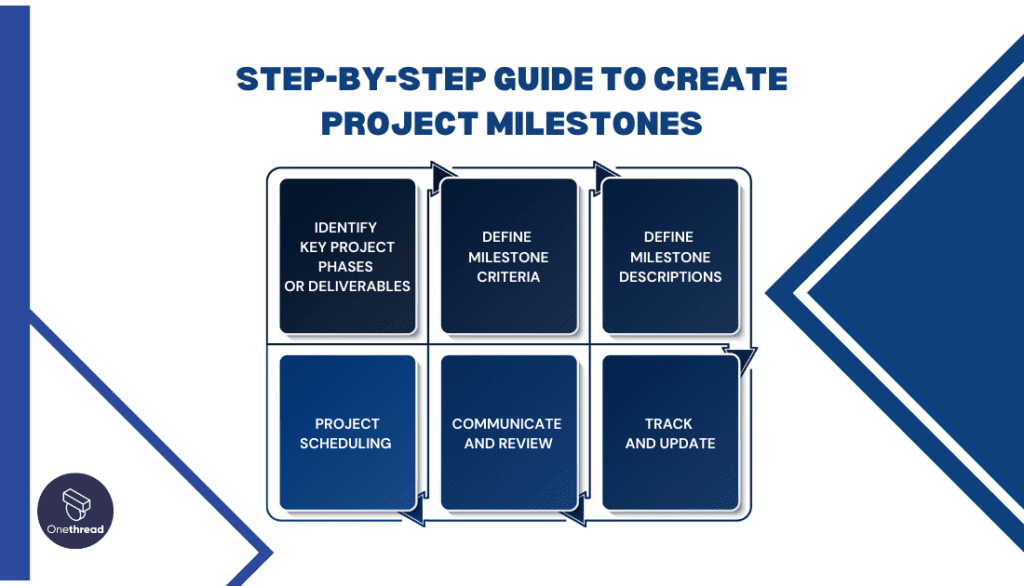
Creating a project milestone is a simple process that can be done in a few steps. Here’s an easy step-by-step guide to help you create project milestones:
Identify Key Project Phases or Deliverables
Determine the major phases, key deliverables, or significant events within your project. These are the potential milestones that mark significant progress or achievements.
Define Milestone Criteria
Establish criteria for what qualifies as a milestone in your project. Consider the significance, impact, and measurability of each potential milestone. Ensure they align with project goals and enable effective tracking.
Define Milestone Descriptions
For each milestone, write a concise description that clearly communicates what the milestone represents or what needs to be achieved to reach it. Ensure that the description is specific, measurable, and easily understood by the project team and stakeholders.
Project Scheduling
Assign target dates to each milestone based on project timelines and dependencies. During your project scheduling, ensure that the milestone dates are realistic and achievable.
Communicate and Review
Share the identified milestones, descriptions, and dates with the project team and stakeholders. Seek feedback and make adjustments if necessary. Ensure everyone understands the purpose and significance of each milestone.
Track and Update
Continuously track the progress towards each milestone throughout the project. Update the milestone status as they are achieved or if there are any changes or delays. Regularly communicate milestone progress to keep everyone informed.
How Do You Visualize Your Project Milestones?
Visualizing project milestones is an effective way to provide a clear overview of your project’s progress and key achievements. Here are a few methods to visualize your project milestones:
Gantt Chart
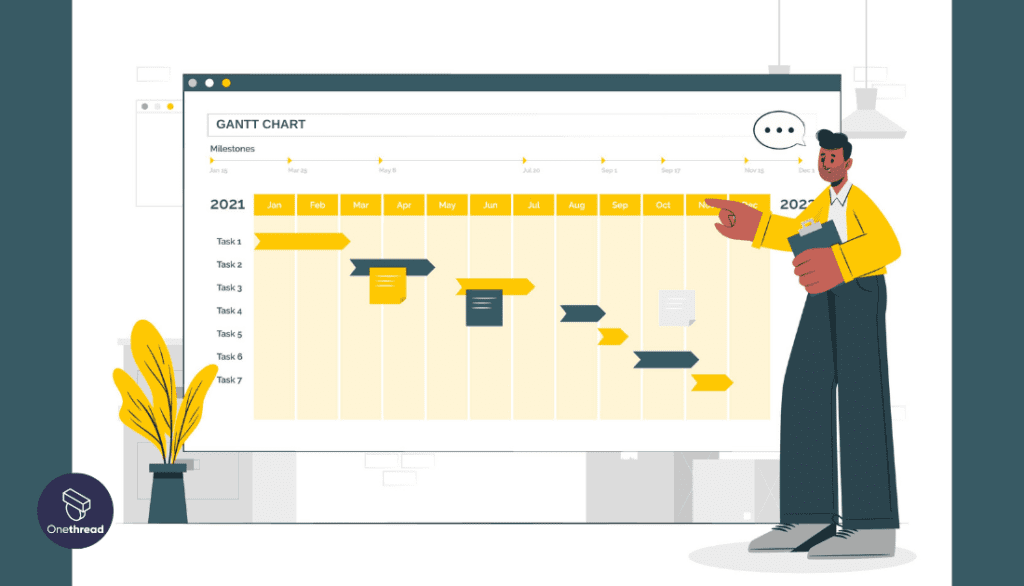
A Gantt chart is a popular tool for visualizing project timelines, including milestones. It uses horizontal bars to represent project tasks, with milestones indicated as specific points on the chart. This visual representation allows you to see the sequential order of tasks, their durations, and when milestones occur.
Milestone Chart
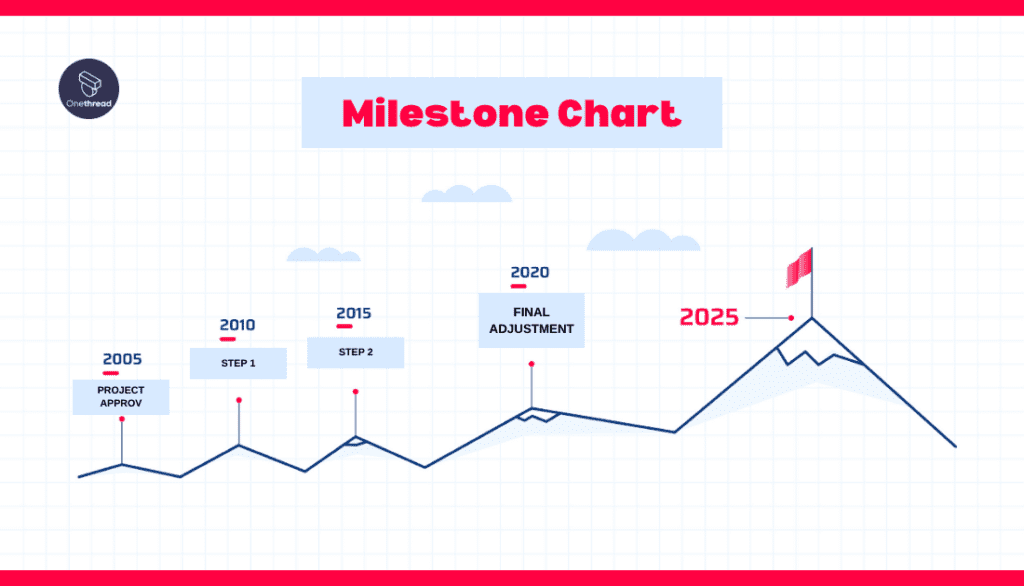
A milestone chart, also known as a timeline chart, focuses specifically on milestones. It presents milestones as distinct events along a timeline. Each milestone is represented by a symbol or marker, making it easy to identify and track significant project achievements.
Kanban Board
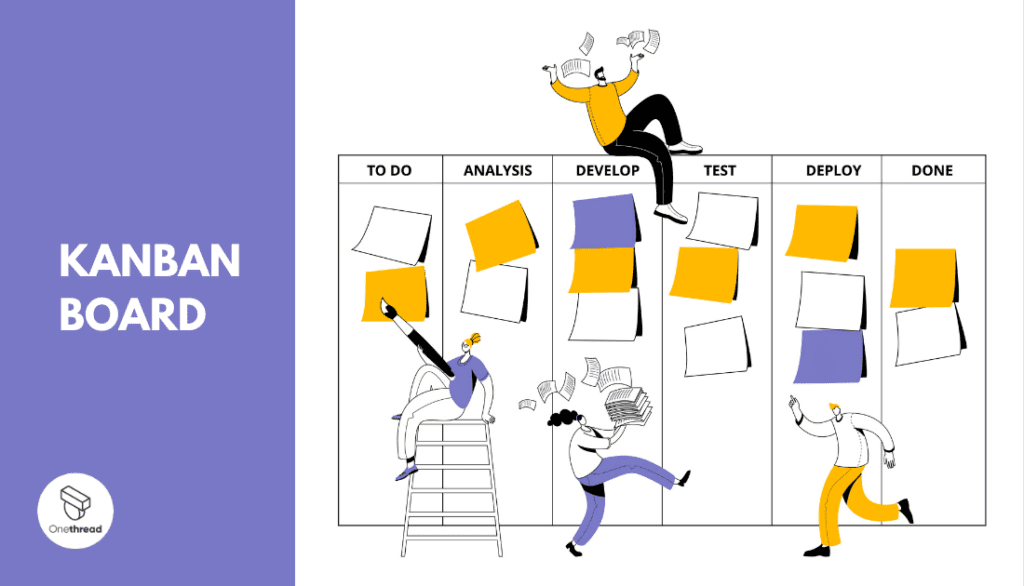
A Kanban board is a visual board divided into columns that represent different stages of work. You can use this board to track tasks, including milestones. Create a column specifically for milestones, and place cards or sticky notes representing each milestone in that column.
Progress Dashboard
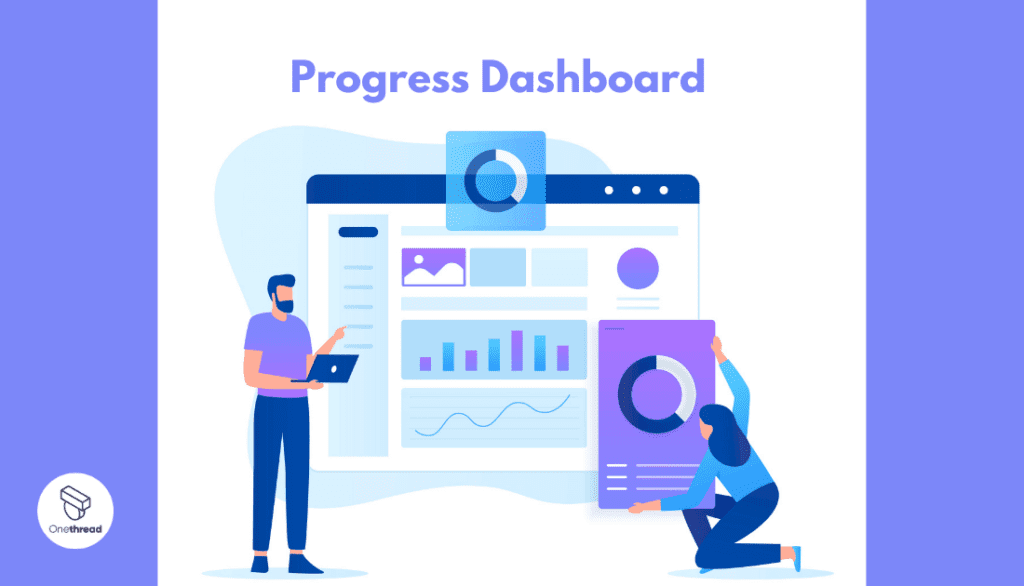
A progress dashboard provides an at-a-glance view of key project metrics, including milestones. It can include charts, graphs, or progress bars that visually represent the completion of milestones. This dashboard helps you monitor milestone progress in real-time and assess the overall project status.
Project Roadmap

A project roadmap is a high-level visual representation of the project’s strategic direction and major milestones. It shows the timeline of milestones, allowing stakeholders to understand the project’s progress and upcoming significant events.
How to Report When a Project Milestone Has Been Reached?
When reporting the completion of a project milestone:
- Clearly state the milestone’s description and significance.
- Provide a summary of activities and deliverables that led to the milestone achievement.
- Include supporting evidence or documentation.
- Communicate the impact on project progress and objectives.
- Outline next steps or upcoming milestones.
- Share the report with relevant stakeholders through appropriate channels, ensuring it reaches the intended audience.
How Do You Share Milestones with Project Stakeholders?
Sharing milestones with project stakeholders is crucial for effective communication and keeping everyone informed. Here’s how you can share milestones with stakeholders:
Determine the Stakeholders
Identify the key stakeholders who need to be informed about the milestones. This may include project sponsors, clients, team members, and other relevant parties.
Choose the Communication Channels
Select appropriate communication channels based on stakeholder preferences and accessibility. This could include project management software, email, collaboration tools, or dedicated project status meetings.
Prepare Clear and Concise Updates
Craft concise updates that clearly communicate the milestone achieved, its significance, and its impact on the project. Use language that is easily understandable to stakeholders who may not be familiar with technical terms.
Use Visual Aids
Supplement your updates with visual aids like charts, graphs, or diagrams that illustrate the milestone’s progress and its relation to the overall project timeline.
Provide Context
Provide context by explaining how the milestone fits into the project’s objectives and timeline. Relate it to the bigger picture and explain its contribution to project success.
The Difference Between Tasks and Milestones
Tasks are specific activities that need to be completed as part of a project, while milestones are significant markers that signify the completion of a major phase or deliverable.
Tasks are actionable items that require effort and resources to accomplish, whereas milestones represent key achievements or decision points in the project. While tasks are smaller, actionable steps, milestones provide a high-level view of project progress and serve as checkpoints to assess the project’s advancement.
The Difference Between Project Timelines and Milestones
Project timelines outline the chronological sequence and duration of tasks and activities within a project, providing a detailed schedule of when each task should be completed.
On the other hand, milestones are significant events or achievements that mark important points in the project’s progress. Timelines focus on the specific timing and duration of tasks, while milestones highlight key accomplishments or deliverables.
What Are Some Common Project Milestone Misconceptions?
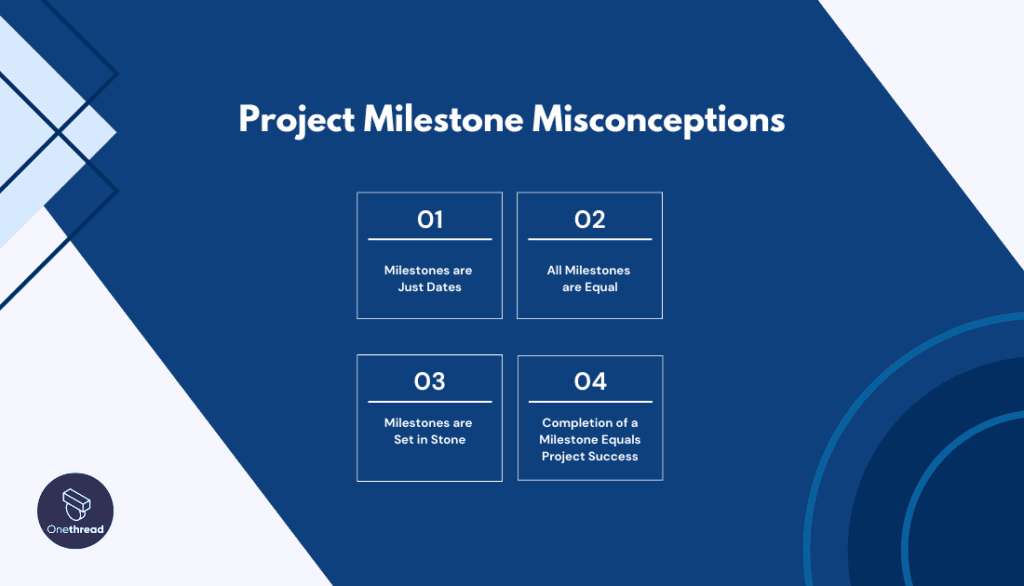
Project milestones can sometimes be misunderstood or misinterpreted, leading to misconceptions that can impact project management. Here are some common project milestone misconceptions to be aware of:
Milestones are Just Dates
A common misconception is that milestones are merely specific dates on the project timeline. In reality, milestones represent significant achievements or events, not just calendar dates. They mark important progress points and deliverables.
All Milestones are Equal
Not all milestones hold the same level of significance. Each milestone should be evaluated based on its impact and relevance to the project’s objectives. Some milestones may be more critical and have a higher impact on project success than others.
Milestones are Set in Stone
Milestones should be flexible and subject to adjustment based on the project’s evolving needs. Misunderstanding milestones as fixed and unchangeable can hinder adaptability and responsiveness to project changes.
Completion of a Milestone Equals Project Success
While achieving milestones is important, it does not guarantee overall project success. Milestones are checkpoints along the project journey, and project success depends on meeting all milestones and delivering the final product or outcome that satisfies stakeholders.
Final Words
So, now you know what is a milestone in project management. A milestone in project management is a significant marker that denotes progress and achievement in a project. It goes beyond being a mere date on a timeline, representing key deliverables, events, or decision points.
Milestones provide clear checkpoints to track progress, communicate with stakeholders, and celebrate accomplishments. Understanding the importance of milestones helps project managers effectively plan, monitor, and report on project status.
Embracing milestones empowers project managers to navigate the project journey with clarity, purpose, and a shared sense of accomplishment.
